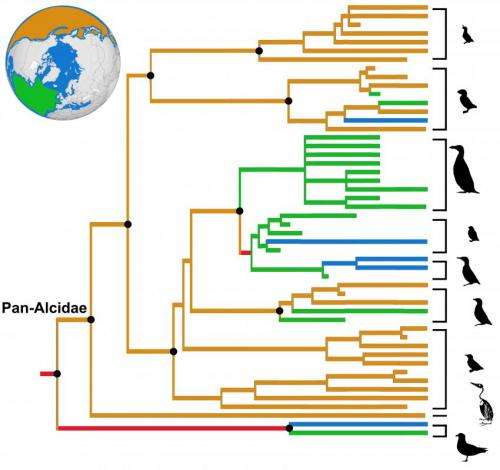Researchers find a strong correlation between Northern Hemisphere seabird diversity and environmental stressors

Modern-day puffins and auks have long been recognized as environmental indicator species for ongoing faunal shifts, and fossil records now indicate that ancient relatives were similarly informative. Researchers have found that puffins and auks may have been at their most diverse and widespread levels during a relatively warm period of Earth's history. The results also explain how past extinctions have shaped the geographic distribution and population size of existing species.
Authors Adam Smith of the National Evolutionary Synthesis Center (NESCent) in Durham, N.C., and Julia Clarke of the University of Texas at Austin examined 28 extinct species in addition to 23 living species. Whereas previous research focused primarily on surviving members of the alcid family, this study was able to paint a more comprehensive picture of their evolution. The findings, which were just published online at the Journal of Avian Biology, support a connection between the diversification of wing-propelled diving seabirds and major climatic events. Such environmental conditions also appear to have influenced the physical traits observed in existing alcids like dovekies, murres, murrelets, puffins, auklets and auks.
The results indicate that the Pan-Alcidae clade, including all living auks and puffins as well as extinct species, first emerged about 35 million years ago. Through phylogenetic analyses of fossils and current species, the researchers were able to estimate "ghost lineages," a method of approximating gaps in the fossil record. By using ghost lineages to extrapolate species diversity over time, the scientists found that pan-alcid species enjoyed the most variety and widespread ranges about 15 million years ago during a period that climate scientists refer to as the Middle Miocene Climatic Optimum.
The researchers found that the geographic distribution and population size of modern alcids are primarily the result of extinctions corresponding with climate and ocean shifts over the last 5 million years. As ocean circulation changed and water surface temperatures cooled dramatically throughout a series of ice ages, species diversity bottlenecked for both Atlantic and Pacific Ocean species. More than 50 percent of species went extinct at this time, which roughly coincided with changes in ocean basin circulation, such as the onset of Gulf Stream circulation. The results contextualize contemporary changes in geographic range and decreases in population sizes of seabirds due to global warming and overfishing.
Smith and Clarke also considered the evolution of wing-propelled diving—a rare behavior found in only one-half percent of all birds. Previously assumed to be a nascent feature of the earliest alcid species, underwater diving could have first arisen as an escape tactic rather than a feeding strategy, according to the study results. Relatives like seagulls and terns plunge from the air, whereas modern puffins and auks dive from a floating position. By reconstructing the ancestral diet, the authors found that early species most likely fed on vertebrates close to the surface; they hypothesize that alcids gradually began to dive deeper and hunt invertebrates such as crustaceans and shrimp, which are included in the diet of some modern species.
The study elucidates how extinct alcids were affected by climate change and other environmental pressures—an area that has been somewhat neglected. Smith and Clarke hope that the results will strengthen modern conservation efforts by lending context to the plight of their modern kin and other seabirds.
More information: Journal of Avian Biology. onlinelibrary.wiley.com/doi/10 … 1/jav.00487/abstract
Provided by National Evolutionary Synthesis Center (NESCent)




















